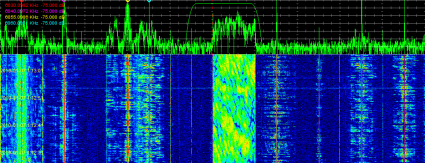I recall burning three or four weeks of a sabbatical getting Saccade.com on the air with Wordpress. So much tweaking…
Digital Radio Mondiale, recorded on the SDR-IQ, decoded with GNU Dream
Digital Radio Mondiale is a new digital broadcasting standard that is being used on shortwave. Sadly, its one of those annoying standards that relies on all sorts of patented technology, which makes experimentation really difficult and annoying. But I heard that Sackville Canada echoed Radio Chinas DRM broadcasts here to the U.S. for an hour a day, so I set up my new SDR-IQ to record ten minutes of it while I was at work the other day. Here’s the spectrogram, showing the near solid block of DRM right in the middle:
It took me a few tries to figure out how to decode this. In the end, what I did was playback the I/Q recording with Spectravue. The signal was centered around 6.080Mhz, so I tuned the SDR-IQ ten kiloherz below, and put it into WUSB mode, after adjusting the filters to pass between 3Khz and 18khz (I left some slop on both sides). I then re-recorded the demodulator output into a wav file. While you can’t open wav files directly from the menus, if you invoke the drm decoder with the wav file as an argument, it will use the wav file as input. I then recorded the resulting decode using Audacity. Here’s a sample. There are some drop outs, but overall the quality is quite good. It would be a bit better if I didn’t recompress the output as an MP3, but hey, it’s a faster download this way.
Digital Radio Mondiale of Radio China, via Sackville, CA
I’m not sure what this is good for, but it was an interesting experiment for my new radio.
Comments
Comment from KC5CW
Time 1/8/2010 at 5:46 am
Join the gang at DRM North America:
Comment from Mark VandeWettering
Time 1/8/2010 at 9:17 am
I’ve contemplated purchasing VAC, but here’s the thing: it’s not open source, nor is it free. What’s more, it’s actually more expensive (by a factor of two or more) than simply buying an additional little USB sound adapter and using that to route the sound (with actual physical cables gaso!). And, I have one of those USB gadgets around, so it doesn’t cost me anything.
Comment from Don, WB9MJN
Time 1/9/2010 at 7:10 am
Hi Mark,
I found your blogsite a couple weeks ago, and have been going through the various posts. It has opened my eyes to allot of stuff that has been going on in Ham Radio, that I was not aware of. I am listening to the WSPR 40 meter channel as I type this. What a neet thing!
I got back into HF activities because of the interest in DRM. I fixed my stagnant TR-7, modified it for DRM reception and built a magnetic loop antenna. Its been a few years of DRM listening here already.
DRM can be frustrating, but it can be fantastically effective as well. It depends allot on what the broadcasters set up the transmission for. The Sackville broadcasts are setup for continental coverage, and work well for that. This time of year we loose the signal here in Chicagoland on 9800 KHz pretty early in the day, however (like 4:30 pm). The stereo broadcasts on 9790 from Sackville are very effective here in the summer (6 to 7 pm central time).
If the broadcaster sets up the signal for dx purposes, such as Vatican Radio (presently on 7370) DRM can outdo AM dramatically. This is due to the interlieving of the data on all the carriers. If a fade takes out your AM carrier , well the signal sounds terrible, if not totally illegable. And SSB is too narrow in bandwidth to avoid complete fade-outs. As the fade bandwidths are typically much narrower than 10 KHz , and that leaves all the other carriers still receiving in a DRM signal. With the digital encoding and interlieving the signal still comes through solid. 2300 UTC is such a time when fading on European paths is terrible on 40 meters. But, Vatican radio comes through very solidly day after day…
Comment from Vladimir
Time 2/14/2010 at 4:08 am
Thank you for this record.
Could you please to publish IF record (between 3Khz and 18khz) before
DREAM decoding? I think It would be interesting to see SNR of radio signal in
real environments.

Comment from Eric Soderman
Time 1/8/2010 at 12:10 am
You can use Virtual Audio Cable to output the sound to so Dream can access it directly, and you can then listen live if you want.
BTW, congrats to your SDR-IQ, a very fine radio, but I just sold mine as I now have a QS1R with all software open source.
BR
Eric (Sweden)